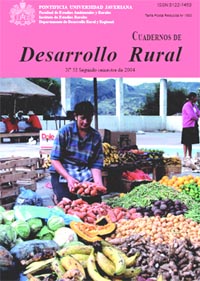Resumo
Los procesos de reforma agraria (1965-1973) y de “contra reforma” (1973-1981) de la dictadura de PINOCHET tuvieron consecuencias imprevistas sobre la estructura predominantemente bimodal de tenencia de la tierra del semiárido Norte Chico de Chile. Creando una fórmula legal cuyo central elemento consiste en la indivisibilidad de la tierra como forma de manejo de este recurso natural, mediante las sociedades de secano, el estado juega un rol central en la nueva estructura agraria local, confirmando así la importancia del medio ambiente geográfico en la conformación de un tipo nuevo de propiedad, misma que guarda similitud con la propiedad comunal de la tierra que históricamente se ha desarrollado en el Norte Chico de Chile. Es bajo PINOCHET que esta forma de propiedad se hace extensiva a extierras de latifundio, reforzando paradójicamente así, dentro de un contexto neo-liberal de privatizaciones, indirectamente la institución de los comunes.
Propriedade intelectual:
Instituto de Estudios Rurales, Facultad de Estudios Ambientales y Rurales, Pontificia Universidad Javeriana, Bogotá, Colombia.
O envio de um artigo para a revista Cuadernos de Desarrollo Rural, indica que o(s) autor(es) certifica(m) e aceita(m):
- Que ele não tem sido publicado, nem aceito para publicação em outra revista.
- Que, no caso de sua publicação for aceita, se o artigo ter uma versão previa como working paper (literatura cinza) ou aparecer numa site da internet, deverá ser retirado dele, ficando somente o título, resumo, palavras-chave e hipervinculo à revista.
- Que uma vez publicado em Cuadernos de Desarrollo Rural não será publicado em outra revista.
Ao enviar artigos para avaliação, o(s) autor(es) aceita(m) transferir(em) os direitos de autor à revista Cuadernos de Desarrollo Rural, para os efeitos da sua publicação na versão impressa ou eletrônica, mesmo firmará a licença de uso parcial anexa.
Responsabilidade de conteúdos:
O conteúdo dos artigos publicados por Cuadernos de Desarrollo Rural é de exclusiva responsabilidade do(s) autor(es) e não necessariamente reflete o pensamento do comitê editorial e científico da revista Cuadernos de Desarrollo Rural. Os textos podem se reproduzir total ou parcialmente, mas citando a fonte.
A publicação opera de acordo com a Creative Commons Attribution License (CC), "Alguns direitos reservados". Para as licenças CC, o princípio é o da liberdade criativa. Este sistema não se opõe aos direitos autorais, mas complementa-se com eles. Somos conscientes da importância dos direitos de autor na nossa cultura.
Creative Commons oferece um sistema que automatiza a pesquisa de conteúdos "comuns" ou sob licença CC. Assim, ao licenciar o seu trabalho, o criador estabelece as condições gerais que são digitalmente incorporadas nele, para que um motor de busca possa identificá-las e escolher a mais conveniente.
This work is licensed under a Creative Commons Attribution-NonCommercial-ShareAlike 3.0 Unported License.


